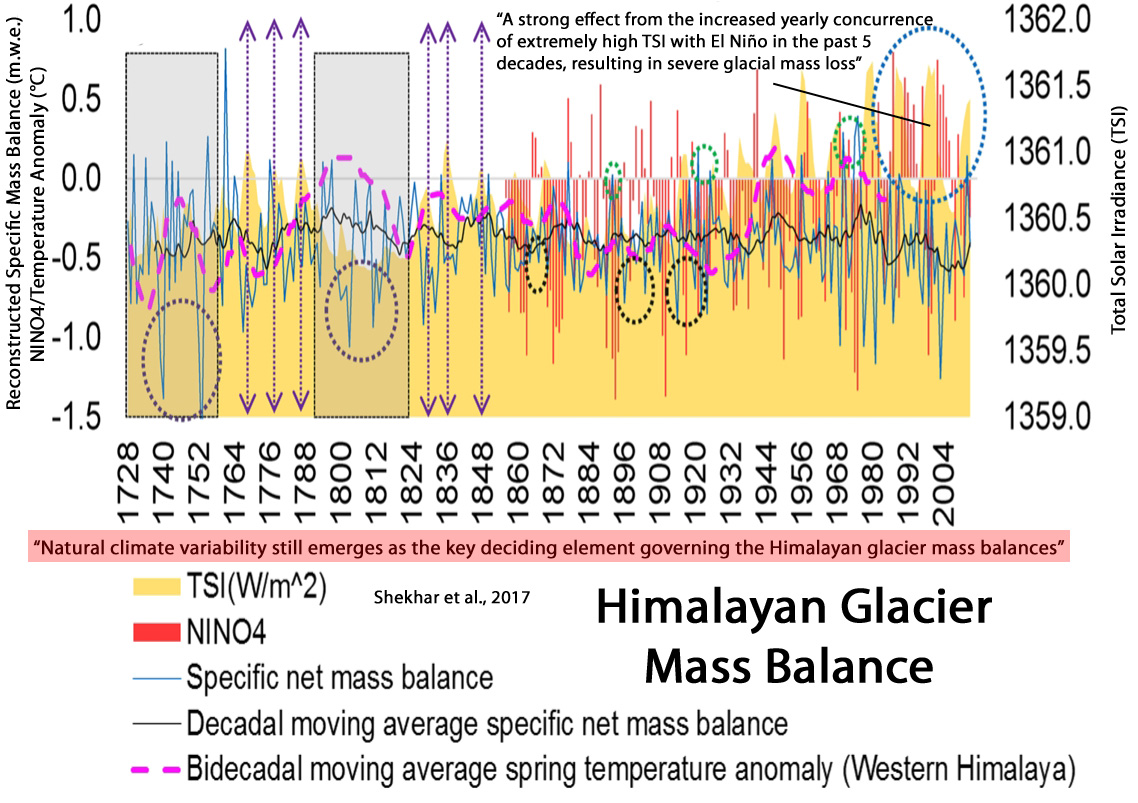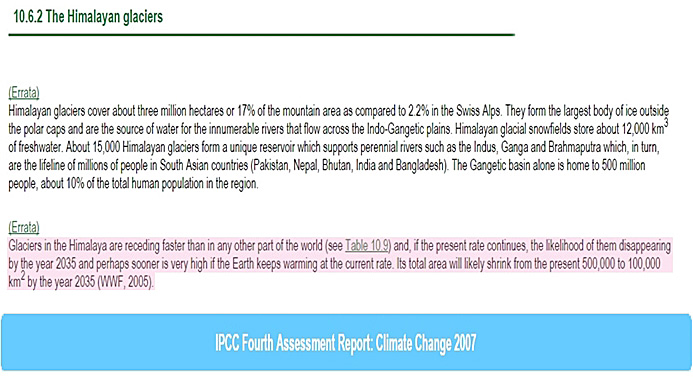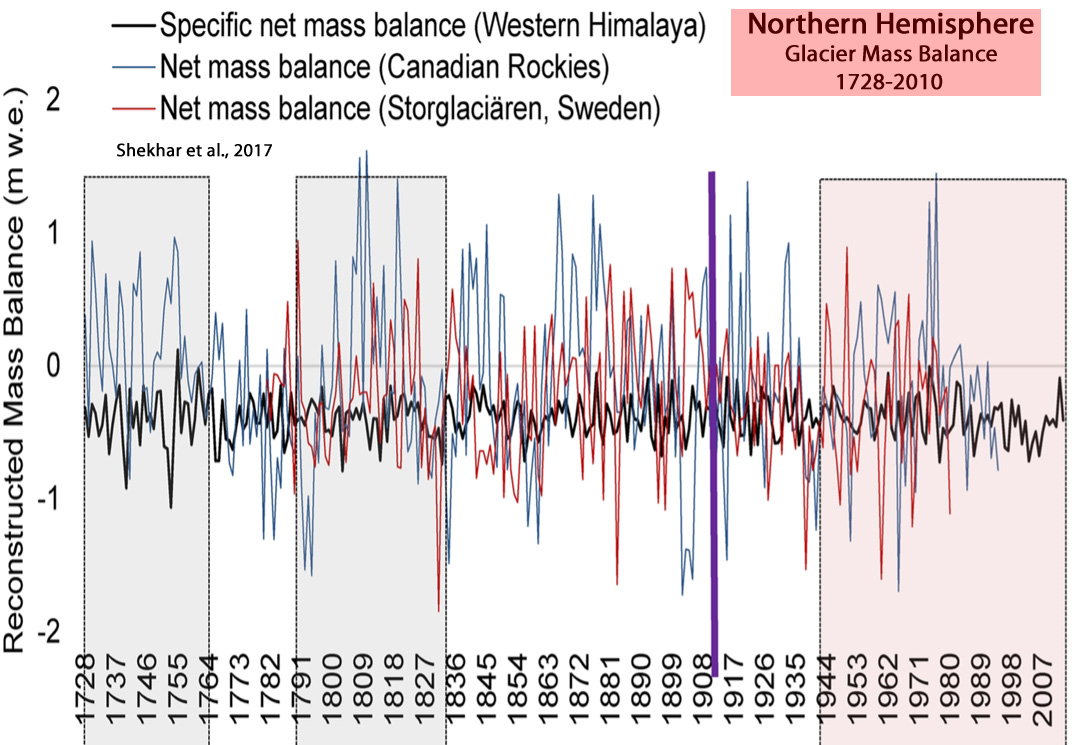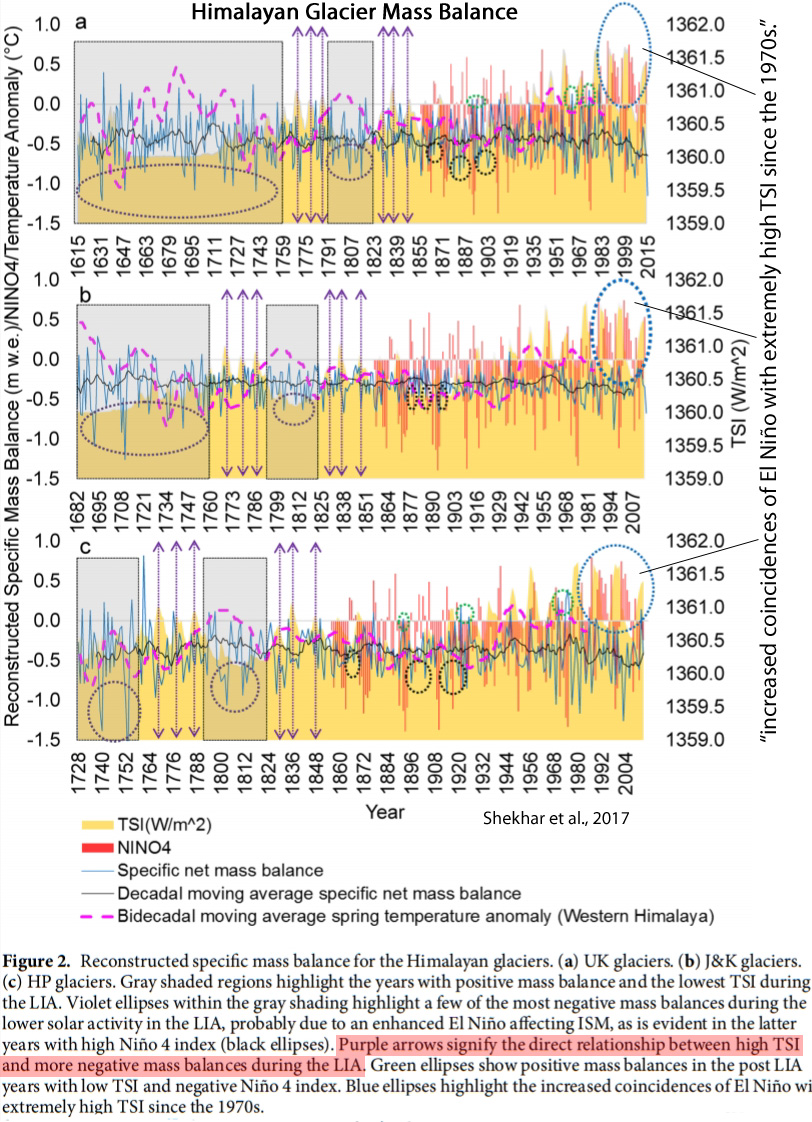Scientists Rebuke Claims Of Human
Control Over Glacier Mass Balance
“Natural climate variability still emerges as the key deciding element governing the Himalayan glacier mass balances.” – Shekhar et al., 2017

Yet another new paper has challenged to IPCC-endorsed conclusion that the Himalayan glaciers are melting rapidly due to anthropogenic climate change, and that these glaciers will very likely “disappear” by 2035.

The claim that the Himalayan glaciers would disappear by 2035 was included in the 4th IPCC report (2007) not for scientific reasons, but to put political pressure on world leaders.
However, a 2014 comprehensive analysis of over 2,000 glaciers in the region indicated that 88% of Himalayan glaciers are stable or advancing, with overall negligible change (0.2%) since 2000.
Prior to this apparent 21st century “pause” in Himalayan glacier melt, a substantial glacier retreat occurred between the 1970s and 1990s for the region. There were also decadal-scale periods of severe glacier melt during the 1600s and 1700s (Little Ice Age), when atmospheric CO2 levels were significantly lower (~275 ppm) than they are now. The amplitude of the glacier retreat during the 17th and 18th centuries sometimes even exceeded the melt rates achieved during the last few decades (Shekhar et al., 2017).
According to a new paper published in the Nature journal Scientific Reports entitled “Himalayan Glaciers Experienced Significant Mass Loss During Later Phases Of Little Ice Age“, the high/low temperatures and melt rates achieved during the Little Ice Age were determined by varying magnitudes of solar activity and El Niño episodes. After the 1970s, Himalayan glacier melt and temperature changes were only “partly” influenced by human activity, but they were primarily driven by solar activity variations (the Modern Grand Maximum) and natural oceanic heat oscillations internal to the Earth’s climate system (El Niño Southern Oscillation [ENSO], North Atlantic Oscillation [NAO], and Atlantic Multidecadal Oscillation [AMO]).
The authors conclude that there is a “robust natural climatic control over the Himalayan glaciers“, even for recent decades. This conclusion contradicts the IPCC’s contention that Himalayan glacier melt is controlled by human activity.
The Himalayan glaciers will not be “disappearing” by 2035.
Shekhar et al., 2017
Half Of The World’s Non-Polar Glaciers (Himalayas) Were Already Melting During 1600s, 1700s
[T]he Hindu Kush-Himalaya (HKH) harbors ~50% (by area) of all the glaciers outside of the polar regions. … Our research is the maiden attempt to reconstruct the longest regional scale glacier mass balance records for the Western Himalaya based on tree-ring sampling at an unprecedented scale. Another highlight of our study is that it presents valid evidence of the significant mass loss experienced by the Himalayan glaciers even during the LIA [1500-1850].
[W]e believe that the episodes of significantly negative mass balances … were the result of an enhanced El Niño affecting the ISM [Indian Summer Monsoon] and increasing the temperatures … [and] a more direct relationship between the high TSI and more negative mass balances during the LIA in the years with potentially weaker El Niño.

‘Extremely High’ TSI, El Niño Since 1970s Resulted In ‘Severe Glacial Mass Loss’
In the case of the Himalaya, the […] phase of rising regional temperatures, and the start of the strong solar cycles that in later years (since the 1970s), started showing substantial coupling with strong El Niño episodes. [M]ass balance periodicities of 9–12 years during ~1970–1990 [are] a representation of the response to a few of the strongest consecutive solar cycles in past 400 years. In fact, we see that ~50% of the years since 1970 experienced an exceptionally high TSI of >1361 W m−2, ~40% of which also underwent warm phases of ENSO.
Although, the study acknowledges the contributions of anthropogenic drivers of climate change in the Himalayan region, it also highlights a strong effect from the increased yearly concurrence of extremely high TSI with El Niño in the past five decades, resulting in severe glacial mass loss.
Natural Variability, With TSI And ENSO, NAO, AMO As Drivers, Control Glacier Mass Balance
Although external anthropogenic forcing can partly control the glacial regime in the Himalaya, the natural climate variability still emerges as the key deciding element governing the Himalayan glacier mass balances. Similar to several other studies for the region, our study also identifies ENSO, NAO, and AMO as the primary drivers of the regional mass balance variability. The fact that the past few decades have experienced intensified episodes of NAO, closely correlating with rising temperature, also suggests a robust natural climatic control over the Himalayan glaciers.






“The claim that the Himalayan glaciers would disappear by 2035 was included in the 4th IPCC report (2007) not for scientific reasons, but to put political pressure on world leaders.”
It couldn’t be science anyway since it was from the mouth of a man over a telephone.
So we are living during a relatively benign climate time with some glacial melt and some glacial gain.
AGW thus far has had little to no impact on the natural cycle that I can see, or maybe others could correct me by indicating where the natural cycle has been distorted by humankind’s ventures.
Comments closed in the other article of yours, so I’ll reply here.
You mentioned the Sun being responsible for water vapor content (pole vs. equator concentration). That’s because of the different temperature, not because the Sun shines at a different angle on the surface. You also mention that the total forcing of CO2 is anywhere between 20-50 W/m2 … can you figure out the equations and calculate the new surface temperature (average) if that kind of radiative forcing were missing, e.g. all the CO2 gone? How would that influence surface temperatures and in turn water vapor content? And how does that change affect temperature increase caused by water vapor GHE?
Is that too hard to understand? You can’t be thinking that every cause/effect stands for itself, can you?
Not only is the Sun responsible for modulating the Earth’s water vapor content for latitudinal reasons (equator-to-pole), it is quite well established in the scientific literature that even the 11-year solar cycle modulates the water cycle, with the solar maxima and minima well-correlated with precipitation/humidity/integrated water vapor.
This also applies to the long-term sunspot number values as determined by spectral analyses — decadal and centennial periods of high/low solar activity are highly correlated with hemispheric-scale monsoon patterns dating back thousands of years. I have a collection of 100s of recently published papers that support this…though I highly doubt you would be interested in even considering them.
In sum, your apparent assumption that the water cycle and water vapor concentrations are not affected by even the most modest variations in solar irradiance is not supported by the evidence. The Sun modulates atmospheric water vapor content. The water vapor concentrations in the atmosphere are the most dominant greenhouse gases operating within the greenhouse effect, with cloud cover variations an even more influential LW factor than water vapor, meaning that changes in CO2 concentrations are overwhelmed by changes in both water vapor and cloud cover, which is why the greenhouse effect can go on W m-2 hiatus (Song et al., 2016) despite 45 ppm increases in CO2 concentration.
That’s quite a spread, isn’t it? What total forcing value do you believe in, SebastianH? 20 W m-2? 32 W m-2? 50 W m-2? And why do you think there is such an enormous error/uncertainty range in CO2 forcing? Don’t we have more precise measurements than that?
And considering the total CO2 RF change during the last 265 years is alleged to be a modest 1.8 W m-2, don’t you think an error/uncertainty range of 30 W m-2 (20-50 W m-2 total RF) in the absolute values for CO2 is problematic if we’re trying to figure out the extent to which CO2 forcing affects surface/ocean temperatures?